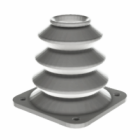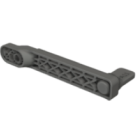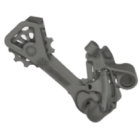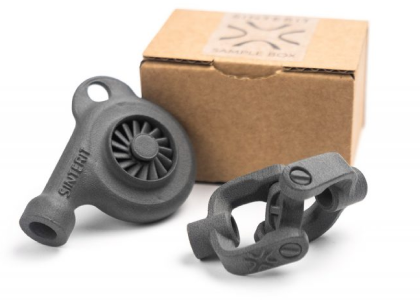Raw materials for 3D printing
The foundation of every successful 3D print lies in its material. Whether you’re working with plastic, resin, metal, or composites, the raw materials for 3D printing directly influence the quality, strength, function, and cost of your parts. Understanding how these materials behave across different technologies is essential to making informed choices and avoiding costly print failures.
Material forms used in FMD, SLA, SLS and metal 3D printing
Each 3D printing method uses a distinct form of material suited to its process. In FDM, printers extrude thermoplastic filament, melted layer by layer to form the object. SLA and DLP systems cure liquid resin using UV light to harden the part geometry. Powder-bed systems like SLS, MJF, and DMLS rely on fine powders — whether polymer or metal — that are selectively fused using heat or laser energy.
Though the delivery methods differ, the principle is the same: a raw feedstock becomes a functional part through controlled layer-by-layer transformation, with no molds, cutting tools, or subtractive operations required.
Thermoplastics for FDM 3D printing
For FDM printing, thermoplastic filaments are the most widely used raw materials. These include:
- PLA – Easy to print and biodegradable, suitable for conceptual models,
- ABS and PETG – Tougher and more heat-resistant, ideal for functional prototypes,
- nylon – Strong, wear-resistant, but sensitive to moisture,
- engineering filaments – Such as polycarbonate, PEI (Ultem), or carbon-fiber-reinforced blends for industrial applications.
These materials are cost-effective and mechanically capable, especially when printed with a well-tuned slicer and in controlled conditions. However, some — like nylon or TPU — are hygroscopic and require drying before use to avoid issues like warping or poor layer adhesion.
Photopolymer resins used in SLA and DLP 3D printing
In resin-based technologies, photopolymer resins are used as raw material. These UV-reactive liquids cure under controlled light exposure, enabling excellent surface finish and fine details. Common resin categories include:
- standard resins – For high-detail prototypes,
- tough resins – With improved mechanical resistance,
- castable resins – Used in jewelry and dental molds,
- biocompatible resins – Certified for dental and medical devices.
While resins offer precision and aesthetics, they tend to be brittle and sensitive to UV degradation unless properly post-cured. Handling and disposal also require care, as uncured resin can irritate skin and must be treated as chemical waste.
Powder materials in SLS, MJF, and DMLS 3D printing
Powder-based technologies demand stricter control of material properties. In SLS and MJF, polymer powders such as PA12, PA11, or TPU are used. The flowability, particle size, and shape directly affect layer uniformity and final part quality.
For metal printing, such as DMLS or SLM, the powders are often made from:
- stainless steel,
- titanium alloys,
- aluminum,
- inconel (nickel-based superalloys),
- tool steels,
- cobalt-chrome.
These fine metal powders must be atomized to achieve a spherical shape, which promotes even layering and reliable melting. Because they are highly reactive at high temperatures, they require inert gas environments and tight contamination control.
Key material properties to consider
Choosing the right raw material for 3D printing involves balancing several performance criteria:
- mechanical strength and elasticity,
- heat resistance,
- surface finish and resolution,
- chemical resistance,
- post-processing compatibility,
- cost per unit of material,
- recyclability or reusability in powder-based systems.
Understanding these factors is essential when matching materials to applications — from high-detail prototypes to load-bearing functional parts.
How to store and manage raw 3D printing materials
Choosing a material isn’t the end of the story — managing it correctly is equally important. Moisture, oxygen exposure, or improper storage can degrade raw materials before they ever reach the printer. Many materials, especially nylons and TPUs, require drying prior to printing. Metal and polymer powders must be stored in sealed containers and often reconditioned (sieved, refreshed) after each print cycle.
In powder-based systems, particularly SLS and metal, maintaining the right refresh ratio between new and used powder is key to ensuring consistent part quality. Too much reused material can lead to incomplete fusion, poor surface finish, or dimensional drift — especially over larger builds.
Why raw materials matter in 3D printing performance
The term raw 3D print material isn’t just about feedstock — it refers to the starting point for the entire manufacturing process. Whether you’re printing a dental guide, a lightweight drone bracket, or a functional prototype, the raw material dictates not just how your part will print, but how it will perform under real-world conditions.
Selecting the right material means balancing printability, mechanical performance, aesthetic quality, and environmental resistance. In many cases, material choice defines whether a print will succeed before the first layer is even laid down.
Material innovation and sustainability
One of the most promising areas of development lies in sustainable raw materials. This includes biodegradable PLA, bio-based nylons (such as castor oil-derived PA11), recycled polymers, and closed-loop powder reuse systems in SLS or MJF. As the industry matures, the shift toward eco-friendly materials is not only environmental but economical, improving ROI and reducing waste.
Summary
Raw materials are the backbone of 3D printing — they define the capabilities of your process, the fidelity of your output, and the performance of your final part. As additive manufacturing continues to grow in complexity and scope, understanding the landscape of available materials is essential. Whether you’re printing with filaments, powders, or resins, the right raw material choice will unlock new applications, optimize production workflows, and ensure reliable, high-quality results.
Explore also
- Polymers in 3D printing
- 3D printing of metals
- Biocompatible materials for 3D printing
- Composites 3D printing
- Recycled 3D printing filament
- 3D printing flexible
- Filament types for 3D printing
- What material does a 3D printer use?
- 3D printing strongest material
Related categories













